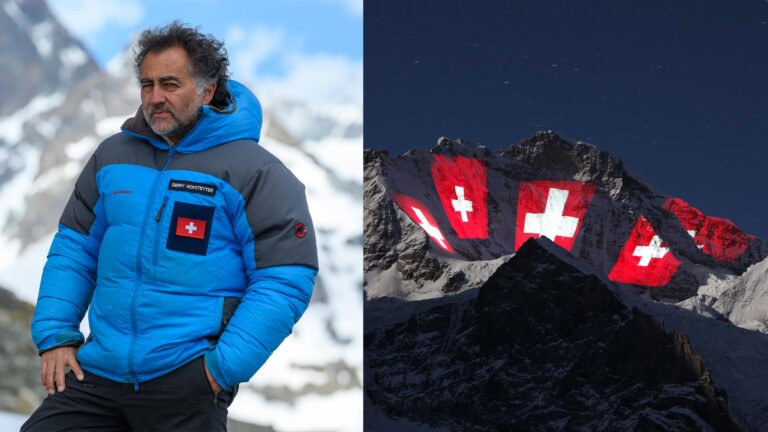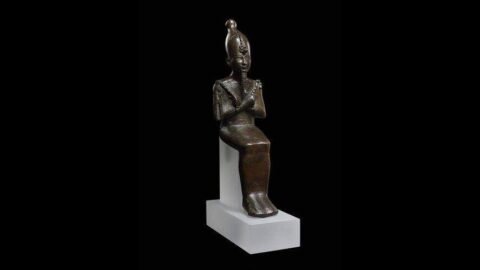The Embassy of Switzerland’s building in New Delhi almost feels like a recollection of post-independence India narrated through architecture. The brutalist building by Swiss architects Hans Hofmann and Walter Rüegg, inaugurated by the first Prime Minister of India, Jawaharlal Nehru, appears to communicate a story of diplomacy, even after 59 years. An architectural style that has explored a new language of concrete, it is a bold statement of structural articulation and radical geometric form respecting the microclimate. In this space that translates independent India’s architectural obsession, the Embassy building in itself is a pleasant reliving of expressionism of the 1960s. The evening of October 28, 2022, presented the Embassy in a new light, the illuminated building welcomed guests of various nationalities, and hosted the finale of the Swiss network’s Swiss it!— a public diplomacy initiative. Marking this occasion, at the event In the Light, Swiss artist Gerry Hofstetter transformed the garden of the Embassy and the building into a story written in the accretion of light.
Placing a hope sign at the Matterhorn mountain, a Kingfisher on an Arctic Iceberg, Britain’s late Queen Elizabeth II and late Prince Philip, Duke of Edinburgh on the clouds above the Swiss Bernese Alps sky, and Titanic on an iceberg of Greenland, Hofstetter presented his rendition of expressing art through light. Merging his love for travel, art and light, the light artist has managed, over the years, to conquer altitudes of mountains, depths of seas and heights of the skies to communicate relevant discussions of the current world including climate change, global warming, hope and peace, through his works. Renowned for his vigour to place light art at the most challenging locations and leave a thought-provoking mark on the viewers, Hofstetter’s art is an immersive experience. Having witnessed these traits in his multiple light installations preceding the In the Light event at the Embassy of Switzerland, it stirred much conversation marking Hofstetter’s debut in India. Through the entrance with a series of pilotis, a flight of ascending stairs, a rectangular indoor pond covered in flower petals, and the exposed concrete walls of the Embassy building, one reached the outdoor space where Hofstetter had transformed the huge trees of the garden into his canvas, employing light to paint the visuals. Huge beams of multi-coloured light hit the organic surfaces of the trees to present motifs celebrating India’s 75th Independence and the upcoming 75th anniversary of Swiss-Indian bilateral relations. In the site-specific installation at the In the Light event, were light projects of the national flags of India and Switzerland, a peacock with its train perfectly cast on the imperfection of the tree foliages, Hofstetter’s famous art of the tiger, and leitmotifs of the event.
“Light is hope and India is the land of light, the enlightening light. So we decided to do this event during Diwali Week, the festival of light. So light, hope, and colours come in a fusion and finalise here at this event in this beautiful park,” shared Hofstetter. With an enthusiastic energy, dressed in warm hues of beige, a scarf around his neck, a walkie-talkie in his hand and a timer reminding him of light changes, he sat down with STIR to talk about his works, passion for travel and light, and finding meaning in the work he creates. Witnessing light as a medium for art instigates curious questions, probing how a non-tangible medium such as light becomes a language. We asked Hofstetter how he perceives light as a tool for communication to convey ideas and thoughts. “We are all made out of light, everyone and everything. We need light. The plants, animals, and human beings need light to live on the planet. So, when you do projections as a tool with light, it’s already synthetic and understandable because you understand light. When you use colours and messages at the right moment, at the right time, on a special day, at a special place, and bring back the pictures of it, people see this monument in another ‘light’. They will remember this because the result is always sensible, beautiful, silent, and enlarges a memory for your life and for this building,” he shared.
Hofstetter then peaked into his timer, picked up the walkie-talkie and guided the team through a change in the artwork, giving us a glimpse into his creative process— his way of working and curating the event. That led to a conversation about his process of working on a diverse range of events, locations and his team. “If I am commissioned by a company, whether it be the United Nations, the king or a foundation, I do something for me and something to address climate change. You have to have the idea in the context of what you want to project. I’ll take an example. Starting last week, from India, I will be going to 13 countries where tigers are living for the inspiration of my work related to ‘Save the Tigers’. When we are able to save the tigers, honestly and passionately, then all people on the planet will understand and we’ll be able to save all the other things. Tigers are just an example, a proud animal but that is what I want to achieve with this tool. Following this idea, you need to decide where to work, the monument and place, and the time—monsoon, heat, winter. Then you plan it, get financing from your sponsors and move towards the permissions. The travel may vary from air, cargo, shape, boats, and helicopters, to horses and camels. My team is always the same— the crew, the cameraman, the photographer, my wife, and my elder daughter,” said Hofstetter.” He then added about the equipment and tools that they carry for each project. “These live projectors are developed in our home. It can go up to 20 kilometres. One projector can do the whole mountain. They are very heavy, very hot, and they need to be taken care of. The light projectors need generators too, big ones, almost weighing two tons. Sometimes you have to carry them to high mountains with helicopters and place them because there’s no electricity, and we bring them down and take pictures on the go.”
Diving into the experience of working in diverse locations and causes, Hofstetter said, “You need energy, electricity, food, sleep, and protection from wild animals such as polar bears and tigers depending on where you are working. I have survived a helicopter crash and tsunamis, but in the end, I always get ‘the picture’ to bring back home and inspire people.” In 2003, in support of the United Nations International Year of Water, he illuminated the icebergs of Antarctica from Russian expedition boats, creating visuals of the polar bear on the surface, as an alarming message of the implications of global warming. Vocalising these concerns, Hofstetter and his team projected polar bears, who are inhabitants of the Arctic, on the Antarctic pole, a habitat for penguins. In October 2006, he collaborated with authorities and lit up the White Desert, the Pyramids of Giza, the Sphinx and the Egyptian National Museum as a contribution to the UNO International Year of the Desert and Desertification. In March 2020, during the COVID-19 lockdown, he projected on Matterhorn in Zermatt as a solidarity project. In February 2022, the Eiger North Face in Grindelwald, Switzerland, witnessed tiger visuals at the peak. The project celebrated the Chinese New Year and also threw light on the majestic animal being a significant part of maintaining the ecological balance of this planet.
Concluding the conversation with a note on his love for India, Hofstetter, with an infectious smile, paused a bit, and said, “When I was young, I always felt I had to come here. I was afraid I may not go back to Switzerland if I came. But now, after having seen 87 countries, I have learned a lot of things in life. Now being here is just right, the right time, the right event, and the right moment for me and for India that I am here. So I am ready for India and India is ready for me as we heard from the minister.”
The event celebrated friendship between Switzerland and India, light art as a medium, discussed diplomatic relations, and initiatives for a sustainable future. Talking about the event at the opening night, Swiss Ambassador Dr. Ralf Heckner, mentioned, “In 2019, the Swiss network in India and Bhutan, together with Swiss and Indian sponsors, launched the ‘Swiss it!’ public diplomacy initiative. Under the aegis of this three-year-long initiative, we organised 35 events in 30 cities across India to share experiences about innovations from Switzerland for a sustainable future. This year the project Swiss it on Wheels gave us the opportunity to hold conversations on a sustainable future with over 9000 pupils across India.”





















